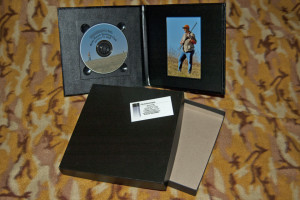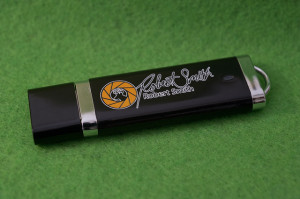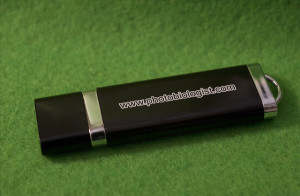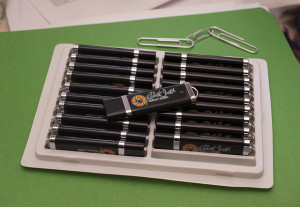Authors note: A recent positive experience with USB Memory Direct prompted this blog post…
Photography is fun. And sharing pictures with others makes it even more fun. I’m using sharing in a VERY broad context. I’m including sharing with friends, sharing with editors, sharing with coworkers, and sharing a final product with a client. Historically, those images were shared as prints, and in many cases, that is still true.
But other times, those images may need to be shared digitally. Social media has made it very, very easy to share lots of pictures with other people very quickly. Sharing one or two high resolution digital images via e-mail is reasonable. But what happens when it is time to share a lot of high resolution images?
Some times when I share a folder of images or a selection of digital images with an editor or other user, I use a “cloud” service like DropBox. But there are times when you want to deliver a physical product, even if you are delivering digital images. Many years ago, I bought a printer that would print images on compact discs. I would save or “burn” the selected images to the CD, and then work up an image and label for the CD and print it on the CD. Sometimes, I’d deliver the CD in a special case that also held a 4”x6” or 5”x7” traditional print.
It’s been more than a few years since I’ve printed an image on CD, though that printer still works. My daughter’s current PC does not even have a CD drive. My current method of choice for sharing a number of images or large files is a USB drive. These little USB drives are also called USB fobs, flash drives, thumb drives, memory sticks, pen drives, and jump drives. It is much easier to put the images on the USB drive than it is to put them on a CD. They are lightweight, easy to transport, and seem to have a good digital lifetime. There are also USB ports on all manner of electronic devices including PCs, televisions, “digital picture frames”, and more.
Not only can I save the digital images on a USB drive, I can also save a PDF version of the imaging license or useage release that tells what rights I am sharing with those images. I also usually put a “contact” file on the drive that has my business contact information on it should whoever end up with the drive in the future need biological or photographic expertise. In the past several months, I’ve had 3 occasions where a USB drive was either the logical or requested method of sharing.
The first was after a land management workshop that I helped facilitate. The workshop information and Powerpoint presentations were all going to be compiled and sent to all the presenters and participants. Traditionally, this would have all be printed out and put into some sort of binder and mailed. In this case, it was significantly cheaper to convert all the files to PDFs with each “slide” having it’s own page and save them to a USB drive than it was to print the same files with 3 “slides” to a page and put them in a spiral or 3-ring binder. The USB drives were also cheaper to mail than the traditional paper booklets would have been.
I was invited to be a featured artist at a small gallery recently. There is limited room to hang images in the gallery, so deciding which traditional prints to hang was not easy. There were several other images that I wish that I could have taken. The good news was that the gallery manager said, “We also have a high-density , flatscreen television mounted just outside the gallery room that you are showing in. Bring a dozen to a hundred of your other images on a USB drive, and we can run them as a loop on the television.” I took a USB driver over, and we plugged it into the USB port on the back of the television, and my images were there in a matter of seconds.
I also do some outdoor event photography. Joe Venus (www.outlawphotography.com) and I recently shot a 2-day event. One of deliverables was a slideshow the last evening with action shots of all the participants. We provided that slideshow on a USB drive. After the event, the organizer asked was there any way that we could provide a copy for each of the participants. Of course there was! Thirty-seven additional USB drives later, each participant has his own version of the show.
USB drives come in a variety of sizes from 64 megabytes to 16 gigabytes or larger. USB drives can also be customized. There are all sort of shapes and colors, and there are all sorts of innovative ways to protectively cover the end that plugs into the electronic device.
I recently acquired 25 personalized USB drives from USB Memory Direct. I am a pretty simple guy, so I chose a pretty simple option. I chose a traditional drive with a removable cap (style DE) that was black with silver accents with my logo/website printed in it’s normal orange, black, and white – though it was divided to print on both sides so that it could be a little larger than if it were put on both sides.
The folks at USB Memory Direct were easy to contact and responded more quickly to my messages than I did to their replies. The digital mock-up of my drives looked good, but they said when they started processing it for real the logo got a little distorted. I resent the image in a vector format, and everything went great. A few days later, I had a very padded parcel of USB drives sitting on my desk! The drives feel solid. The caps are snug. The logos are tough – I scratched on one with my thumbnail, and it looked just like it did before (though I’m sure that if I carry one around in my pocket with change and keys, that it will show signs of wear).
While I did not use any of the additional services that USB Memory Direct offers, they will format the drives in different ways, preload information on them (in hindsight, I should have gone ahead and had them load my business contact information on the drives), and more.
Somehow giving clients a physical product with digital images feels like more of a transaction than delivering those same files through the ether.




